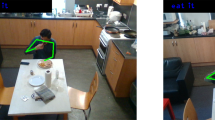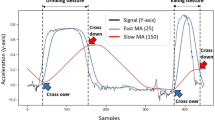Abstract
Under healthcare research, eating activity detection and recognition have been studied for many years. Most of the previous approaches rely on body worn sensors for eating behavior detection. However, measurement errors from these sensors will largely reduce the tracking accuracy in estimating velocity and acceleration. To avoid this problem, we utilize Microsoft Kinect to capture skeleton motions of eating and drinking behaviors. In this paper we introduce a moving average method to remove the noise in relative distances of the captured joint positions so that eating activity can be segmented into feeding and non-feeding frames. In order to identify different eating patterns, eating and drinking behavior recognition is performed based on the features extracted from the resulting feeding periods. The experiments are evaluated on our collected eating and drinking action dataset, and we also change the distance between Kinect and subject to test the robustness of our approach. The results achieve better detection and recognition performance compared with other approaches. This pioneer work of our eating action behavior analysis can lead to many potential applications such as the development of a Web system to facilitate people to share and search their eating and drinking actions as well as carrying out intelligent analysis to provide suggestions.









Similar content being viewed by others
References
Abdur Rahman, M., Qamar, A.M., Ahmed, M.A., Ataur Rahman, M., Basalamah, S.: Multimedia interactive therapy environment for children having physical disabilities. In: Proceedings of the 3rd ACM Conference on International Conference on Multimedia Retrieval, pp. 313–314 (2013)
Amft, O., Bannach, D., Pirkl, G., Kreil, M., Lukowicz, P.: Towards wearable sensing-based assessment of fluid intake. In: The 8Th IEEE International Conference on Pervasive Computing and Communications Workshops, pp. 298–303 (2010)
Bian, Z.P., Chau, L.P., Magnenat-Thalmann, N.: Fall detection based on skeleton extraction. In: Proceedings of the 11th ACM SIGGRAPH International Conference on Virtual-Reality Continuum and its Applications in Industry, pp. 91–94 (2012)
Chang, C.Y., Lange, B., Zhang, M., Koenig, S., Requejo, P., Somboon, N., Sawchuk, A.A., Rizzo, A.A.: Towards pervasive physical rehabilitation using microsoft Kinect. In: The 6Th IEEE International Conference on Pervasive Computing Technologies for Healthcare, pp. 159–162 (2012)
Chen, M., Dhingra, K., Wu, W., Yang, L., Sukthankar, R., Yang, J.: Pfid: Pittsburgh fast-food image dataset. In: The 16Th IEEE International Conference on Image Processing, pp. 289–292 (2009)
Dong, Y., Hoover, A., Scisco, J., Muth, E.: A new method for measuring meal intake in humans via automated wrist motion tracking. Appl. Psychophysiol. Biofeedback 37(3), 205–215 (2012)
Du, Y., Wang, W., Wang, L.: Hierarchical recurrent neural network for skeleton based action recognition. In: Proceedings of the IEEE Conference on Computer Vision and Pattern Recognition, pp. 1110–1118 (2015)
Gao, C., Yang, L., Du, Y., Feng, Z., Liu, J.: From constrained to unconstrained datasets: an evaluation of local action descriptors and fusion strategies for interaction recognition. World Wide Web 19(2), 265–276 (2016)
Hartigan, J.A., Wong, M.A.: Algorithm as 136: a k-means clustering algorithm. J. R. Stat. Soc.: Ser. A: Appl. Stat. 28(1), 100–108 (1979)
Hondori, H.M., Khademi, M., Lopes, C.V.: Monitoring intake gestures using sensor fusion (microsoft Kinect and inertial sensors) for smart home tele-rehab setting. In: The 1St Annual IEEE Healthcare Innovation Conference (2012)
Kalantarian, H., Alshurafa, N., Sarrafzadeh, M.: A Wearable Nutrition Monitoring System The 11Th IEEE International Conference on Wearable and Implantable Body Sensor Networks, pp. 75–80 (2014)
Kalantarian, H., Alshurafa, N., Le, T., Sarrafzadeh, M.: Monitoring eating habits using a piezoelectric sensor-based necklace. Comput. Biol. Med. 58, 46–55 (2015)
Kawano, Y., Yanai, K.: Real-time mobile food recognition system. In: Proceedings of the IEEE Conference on Computer Vision and Pattern Recognition Workshops, pp. 1–7 (2013)
Li, M., Leung, H.: Graph-based approach for 3d human skeletal action recognition. Pattern Recogn. Lett. 87, 195–202 (2017)
Li, M., Leung, H., Liu, Z., Zhou, L.: 3d human motion retrieval using graph kernels based on adaptive graph construction. Comput. Graph. 54, 104–112 (2016)
Malnick, S.D., Knobler, H.: The medical complications of obesity. J. Assoc. Physicians 99(9), 565–579 (2006)
Mastorakis, G., Makris, D.: Fall detection system using kinect’s infrared sensor. J. Real-Time Image Proc. 9(4), 635–646 (2014)
Mettel, M.R., Alekseew, M., Stocklöw, C., Braun, A.: Safety services in smart environments using depth cameras. In: European Conference on Ambient Intelligence, pp. 80–93. Springer, Switzerland (2017)
Nguyen, D.T., Cohen, E., Pourhomayoun, M., Alshurafa, N.: Swallownet: Recurrent neural network detects and characterizes eating patterns. In: IEEE International Conference on Pervasive Computing and Communications Workshops, pp. 401–406 (2017)
Press, W.H.: Numerical recipes 3rd edition: The art of scientific computing. Cambridge University Press, Cambridge (2007)
Qian, R.J., Sezan, M.I., Matthews, K.E.: A robust real-time face tracking algorithm. In: Proceedings of the IEEE International Conference on Image Processing, vol. 1, pp. 131–135. IEEE (1998)
Saini, S., Rambli, D.R.A., Sulaiman, S., Zakaria, M.N., Shukri, S.R.M.: A low-cost game framework for a home-based stroke rehabilitation system. In: IEEE International Conference on Computer & Information Science, vol. 1, pp. 55–60 (2012)
Shen, Y., Salley, J., Muth, E., Hoover, A.: Assessing the accuracy of a wrist motion tracking method for counting bites across demographic and food variables. IEEE J. Biomed. Health Inform. 21(3), 599–606 (2017)
Stunkard, A., Wolff, H.: A mechanism of satiety-function and disorder in Human obesity. In: Psychosomatic Medicine, vol. 18, pp. 515–515 (1956)
Tang, J.K., Leung, H.: Retrieval of logically relevant 3d human motions by adaptive feature selection with graded relevance feedback. Pattern Recogn. Lett. 33(4), 420–430 (2012)
Thomaz, E., Essa, I., Abowd, G.D.: A practical approach for recognizing eating moments with wrist-mounted inertial sensing. In: Proceedings of the 2015 ACM International Joint Conference on Pervasive and Ubiquitous Computing, pp. 1029–1040 (2015)
Vemulapalli, R., Arrate, F., Chellappa, R.: Human action recognition by representing 3d skeletons as points in a lie group. In: Proceedings of the IEEE Conference on Computer Vision and Pattern Recognition, pp. 588–595 (2014)
Wu, W., Yang, J.: Fast food recognition from videos of eating for calorie estimation. In: IEEE International Conference on Multimedia and Expo, pp. 1210–1213 (2009)
Yang, S., Chen, M., Pomerleau, D., Sukthankar, R.: Food recognition using statistics of pairwise local features. In: Proceedings of the IEEE Conference on Computer Vision and Pattern Recognition, pp. 2249–2256 (2010)
Zhang, R., Amft, O.: Monitoring chewing and eating in free-living using smart eyeglasses. IEEE J. Biomed. Health Inform. 22(1), 23–32 (2018)
Zhang, S., Ang, M.H., Xiao, W., Tham, C.K.: Detection of activities by wireless sensors for daily life surveillance: eating and drinking. Sensors 9(3), 1499–1517 (2009)
Zhang, Z., Liu, W., Metsis, V., Athitsos, V.: A viewpoint-independent statistical method for fall detection. In: The 21St IEEE International Conference on Pattern Recognition, pp. 3626–3630 (2012)
Zong, Z., Nguyen, D.T., Ogunbona, P., Li, W.: On the combination of local texture and global structure for food classification. In: IEEE International Symposium on Multimedia, pp. 204–211 (2010)
Acknowledgements
The work described in this paper is supported by grants from City University of Hong Kong (Project No. 7004548 and 7004681), National Natural Science Foundation of China (Grant No. 61402205), China Postdoctoral Science Foundation (Grant No. 2015M571688), and Jiangsu University (Grant No. 13JDG085).
Author information
Authors and Affiliations
Corresponding author
Additional information
This article belongs to the Topical Collection: Special Issue on Social Media and Interactive Technologies
Guest Editors: Timothy K. Shih, Lin Hui, Somchoke Ruengittinun, and Qing Li
Rights and permissions
About this article
Cite this article
Men, Q., Leung, H. & Yang, Y. Self-feeding frequency estimation and eating action recognition from skeletal representation using Kinect. World Wide Web 22, 1343–1358 (2019). https://doi.org/10.1007/s11280-018-0567-0
Received:
Revised:
Accepted:
Published:
Issue Date:
DOI: https://doi.org/10.1007/s11280-018-0567-0




